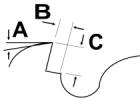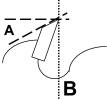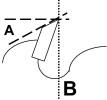 Loading... Please wait...
Loading... Please wait...(800) 346-8274
Free Ground Shipping on Orders over $150!
Over 23,000 Items Discounts up to 40% off Retail
Saw Blade Resharpening
Our Newsletter
- Home
- Technical Info
- Saw Blades
- Saw Blade Sharpening
- Saw Blade Resharpening
Saw Blade Resharpening
Why Saw Blades Don’t Run The Same After Resharpening
There are two principle reasons. First, many saw blades are not sharpened properly. Second, sharpening a saw blade means removing material. When you remove material you change the relationship between several critical angles. See our article- Inspecting Sharpened Saw Blades.
Many blades are just resharpened poorly. A saw blade is a complicated, precision instrument. Look at your saw blade and see if you can find high and low spots in the saw plate. Also see if you can tell how well it is tensioned. Then take it to the person that repairs the saw blades and ask them to show you. It takes a real master to troubleshoot problems.
A good quality saw blade is a precision instrument. It is designed and built to give the best performance right out of the box.
Angles and Dimensions
Saw blades are made with eight or nine relationships or angles to them. These are; Hook angle, Tangential clearance angle, Radial Clearance angle, Top back angle, Shoulder backoff angle, Tip to shoulder overhang, Tip face overhang, Gullet size and maybe a top bevel angle on ATB (alternate top bevel) and similar. Many of these terms are defined in our Saw Blade Glossary.All these angles wear as the saw blade wears. When the blade is resharpened it changes some or all of these angles.
|
Tip width and side Clearance (Front or face view) Difference in width between the tip and the plate A is the tip width. This is sometimes called the “kerf”. The kerf is actually the width of the cut so it is the tip width plus any variation. B is the carbide and C is the saw plate or saw body. |
|
||
|
Shoulder Back off angle and Notch Depth (side view) Slope of the shoulder from the tip to the gullet A is the Shoulder Backoff angle B is the notch width C is the notch depth This is the steel plate before the carbide is inserted in the notch |
|
||
|
Top Back Angle (side view) Provides clearance on the cutting circle A is the top back angle for the carbide B is a line passing though the center of the saw blade |
|
||
|
Tip Overhangs (side view) These overhangs are necessary to provide clearance for the diamond wheel when grinding A is the Tip to Shoulder Overhang B is the Tip Face Overhang |
|
||
|
Tangential (Front to Back) Side Clearance Angle (top view) Clearance from the face (wood side) to the back (saw side) A is the Tangential Clearance Angle B is the carbide tip C is the saw plate |
|
||
|
Radial Clearance angle (face view) Clearance from the top (outside) to the bottom (inside) of a saw tip A is the carbide tip B is the saw plate C is the radial clearance angle |
|
||
|
Hook Angle (side view) The angle at which the tip enters the material being cut A is the hook angle. It is the angle between the face of the tip and a line drawn through the middle of the saw blade. B is the sawplate C is the saw tip |
|
||
|
Face Bevel Angle (top view) The face of the tips are slanted alternately to provide a smaller, sharper edge. ATB (Alternate Top Bevel) is done with the tops of the tips. This is done with the face of the tips. The near drawing is a conventional saw blade where the full face of the tips meets the material being cut all at once. The farther drawing shows alternate face bevel where only a corner of the face initially meets the material being cut much like a wedge splitting wood. |
|
||
|
Top Bevel angle (face view) A is the angle B is the carbide tip C is the saw plate |
|
||
|
Pitch (side view) Pitch is the distance between any two tips in a standard blade. There are saw blades made where the pitch varies from one section to another to break up the resonance of the steel. |
|













